

 The Accurate Reloading Forums
The Accurate Reloading Forums  THE ACCURATE RELOADING.COM FORUMS
THE ACCURATE RELOADING.COM FORUMS  Other Topics
Other Topics  Recipes for Hunters
Recipes for Hunters  project pastramă - 2011
project pastramă - 2011Go  | New  | Find  | Notify  | Tools  | Reply  |  |
| one of us |
this thread will chronicle my pastramă journey, using a venison roast from deer that we have hunted. an important note of clarification: this is NOT pastrami. pastramă and pastrami are related, but there are some subtle, yet fundamental differences. there is some good background on this traditional romanian specialty available, but no need to review it here in this posting. anyone interested in a detailed history and overview of this Romanian specialty can click here: http://foodsoftheworld.activeb...traditional-romanian -pastram_topic283.html much of the information provided was from actual romanians, so it is certainly worth reading. here's the aged and trimmed hind-quarter roast that i will be using, from our 2011 mule deer doe: 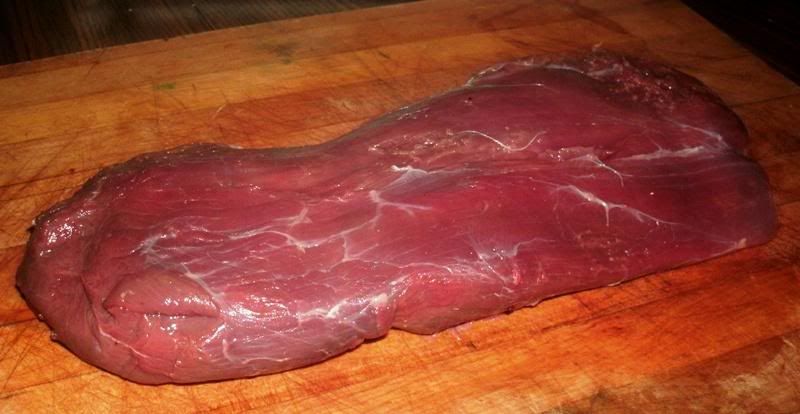 i always have trouble telling the top and bottom rounds apart, but i am pretty sure that it is the top round. as you can see, it's been trimmed of membranes, silverskin, fat etc. and is a nice, clean, wonderful hunk of good montana venison - all ready for the project! as any hunter knows, the weight of any venison roast varies according to the size of the deer, the amount of trimming necessary and other factors. i had actually bought a digital kitchen scale for this project (the only other one i had went to 1 pound only), but since i had misplaced the batteries (and they were those round, nickel-sized ones that aren't available in small towns on sunday evenings), i had to guesstimate the weight. i knew it was more than a pound, but not quite 2 pounds, so all of my measurements (cure, spices etc.) were for a 2-pound roast, in order to be on the safe side of the cure. here are the herbs and spices that i chose to use: 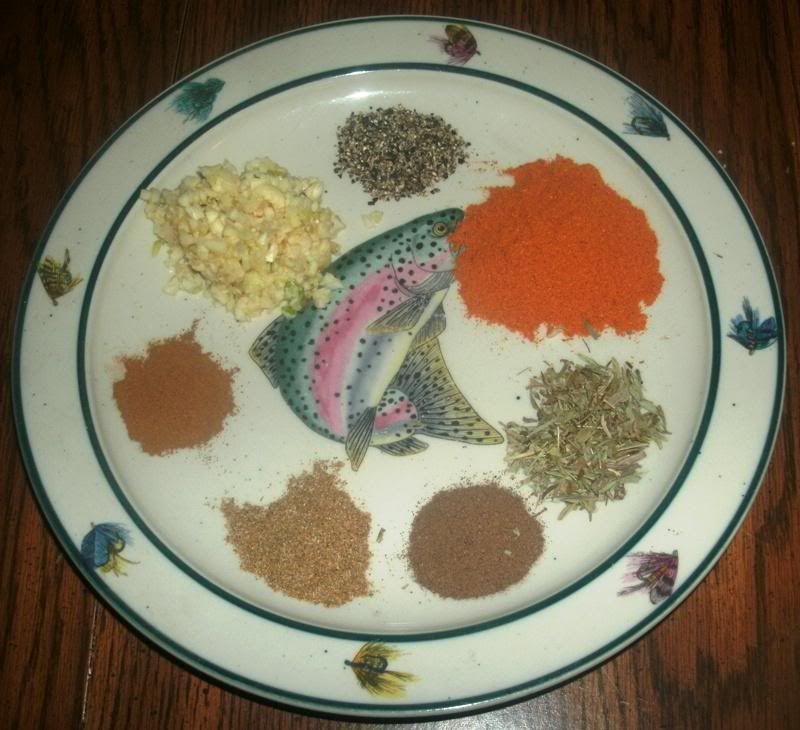 clockwise from the top: 1/2 teaspoon freshly-ground black pepper 1 heaping teaspoon hungarian paprika 1 teaspoon summer savory 1/2 teaspoon ground allspice 1/2 teaspoon ground coriander 1/2 teaspoon ground cinnamon 2 tablespoons fresh crushed-and-minced garlic these particular spices, and their amounts, were derived from a summation and extrapolation of my research. my goal was to use spices that were definitely part of traditional romanian pastramă in amounts that would be consistent with a good balance of flavours. there are other spices that can be used, including (but not limited to) cloves, nutmeg, hot red pepper flakes and wine; however, these would not be as "traditional" to the ur-pastramă as indicated in my research. the end results will tell me if i succeeded, and i can tweak from that point. a note on salt: after seeing the amount of tenderquick involved, i elected not to add any salt for this first attempt, so that the salt would not overwhelm the finished product. i will report on results and add salt to my next preparation, if necessary. a note on sugar: during my research, sugar was mentioned one or two times, but not in the more traditional, romanian accounts - nor in the traditional, romanian recipes - therefore, i left sugar out of the seasoning rub this time (except for the small amount in the cure, of course), opting for ingredients that i knew were traditional. next, i measured out the required amount of tenderquick, as according to package directions for curing meat:  since i was measuring for 2 pounds of meat, i used 2 tablespoons of tenderquick, according to package directions for a dry cure. since the roast was in actuality a little less than 2 pounds, the amount of cure was slightly more than recommended; however,it seems to me that it is better to have slightly more than less, as long as you don't go over by a large amount, especially in light of the lack of ability to get an accurate weight for the meat. i've never cured any large cuts of meat - my curing experience is limited to jerky and ground meat, which use different methods; consequently, i was flying in new territory here and learning as i progressed along. traditionally, pastramă is made with a dry salt cure, but this method is a little advanced for my current skill level in charcuterie; therefore, i elected to use morton's tenderquick cure, and will learn more about salt-only curing for future attempts. on to the execution of this project! first, i laid half the cure down on a plate, then placed the roast on top of it: 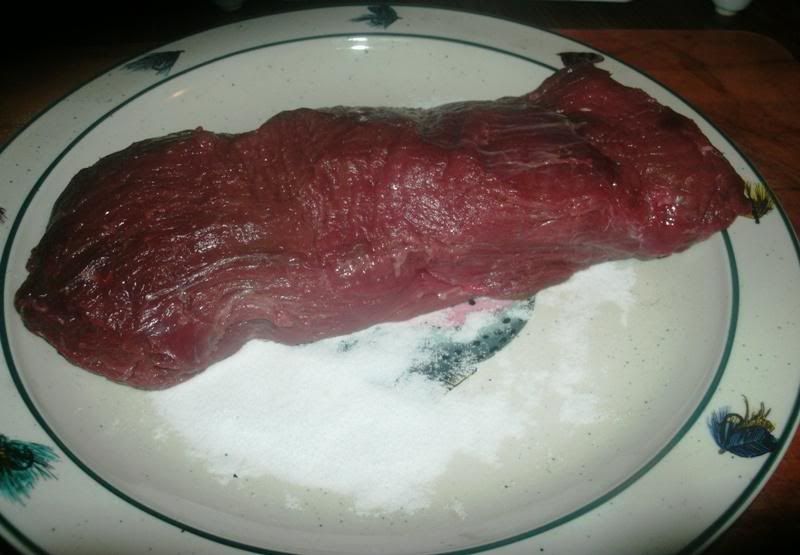 then, i applied the remaining tenderquick on top of the roast, rubbing it in a little and turning it on the plate a couple of times in order to coat evenly. next, i mixed the pastramă spices together: 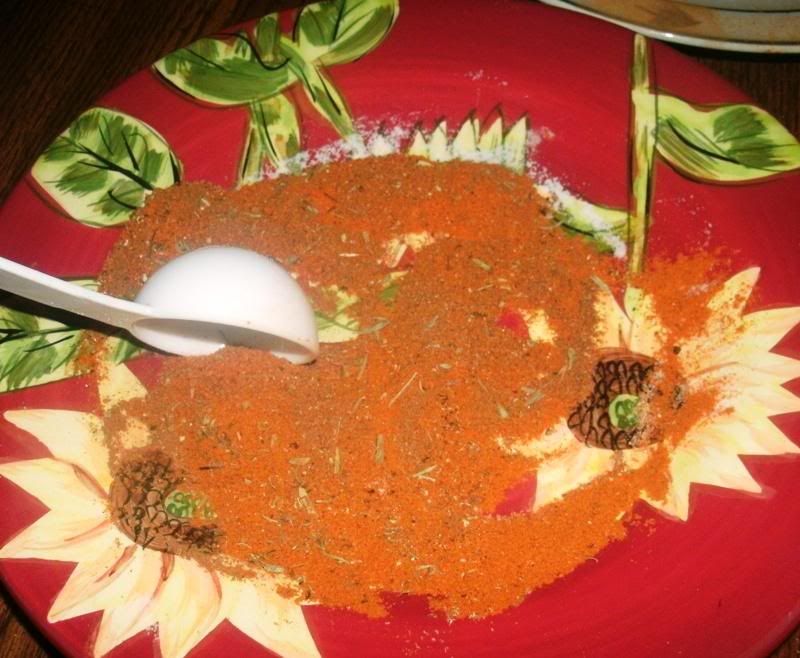 and applied half of the spices to the top half of the roast: 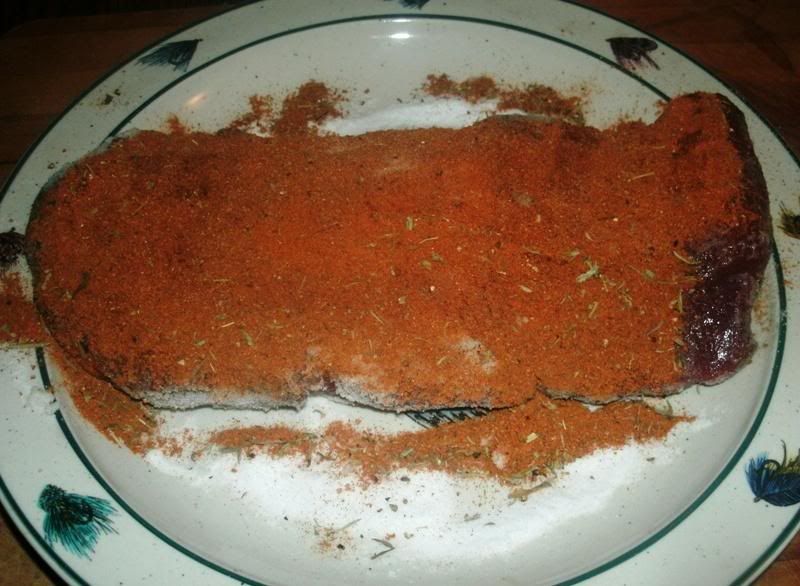 then i added half the crushed and minced garlic: 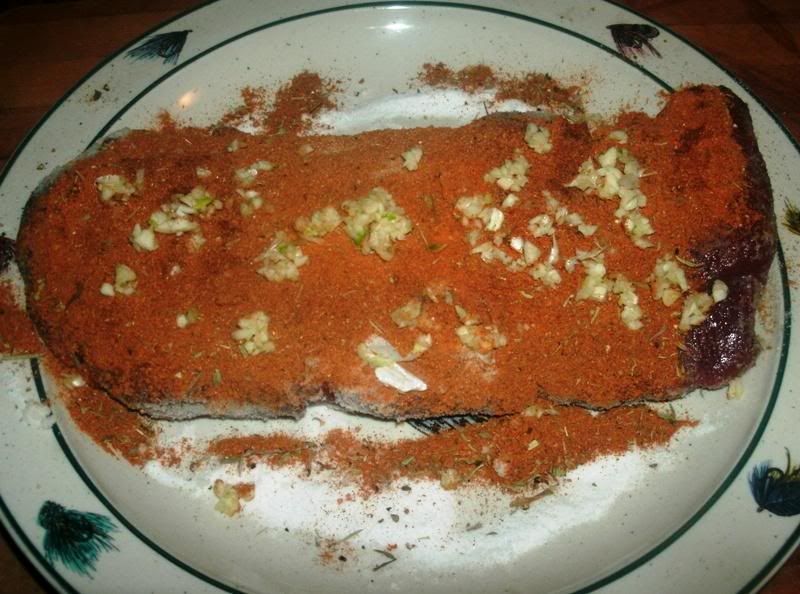 and repeated the spice and garlic steps on the other side of the roast: 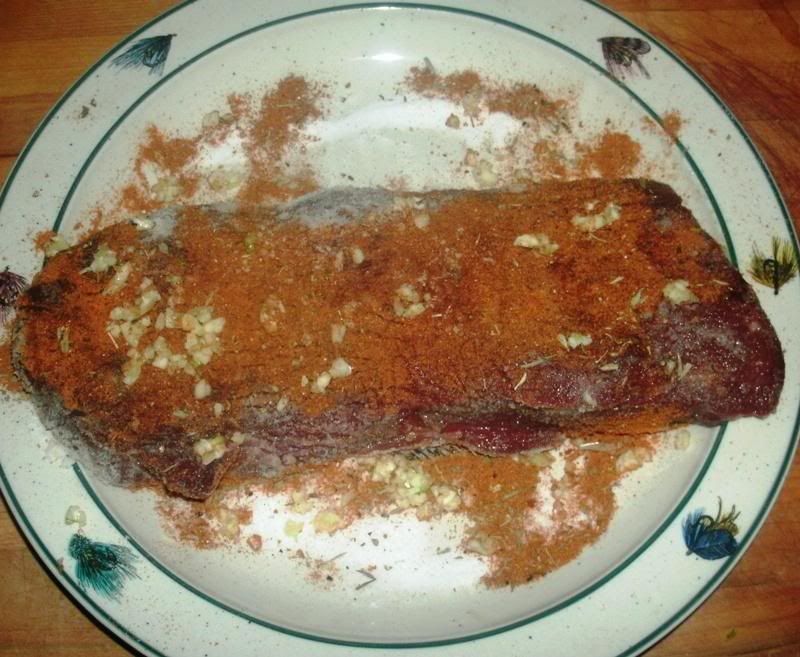 next, i laid the roast in a vacuum seal bag, then i emptied any "leftover" cure and spices from the plate into the bag as well. note for future reference: a paper plate might work better, since it can be folded and poured into the bag. then i vacuum-sealed the bag: 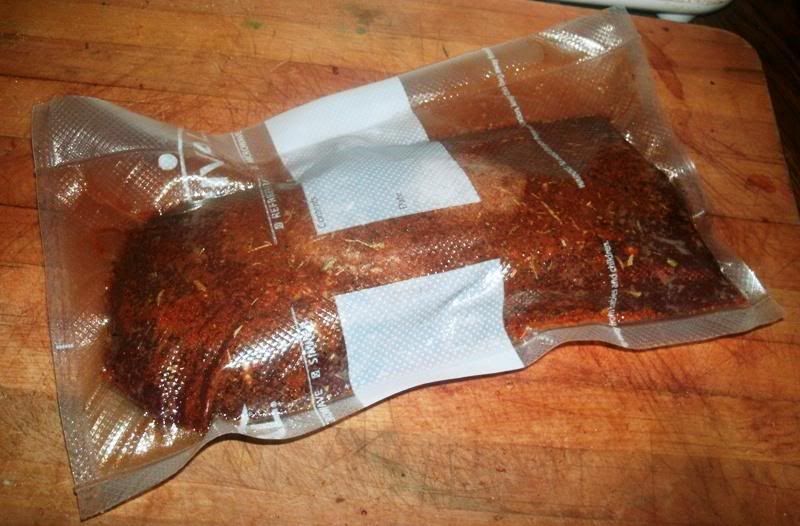 the lighter spot you see on the middle of the roast is where i dumped the remaining spice from the plate. the vacuum-seal method worked very well during my most recent gravlax project: http://foodsoftheworld.activeb...-new-gravlax-project so i decided to use it for this curing project as well. the vacuum seems to help with the absorption and osmosis that takes place during brining, and the seal of course prevents any chance of leakage. i labeled the bag, including the project, the date i began the cure and the date that the cure would finish: 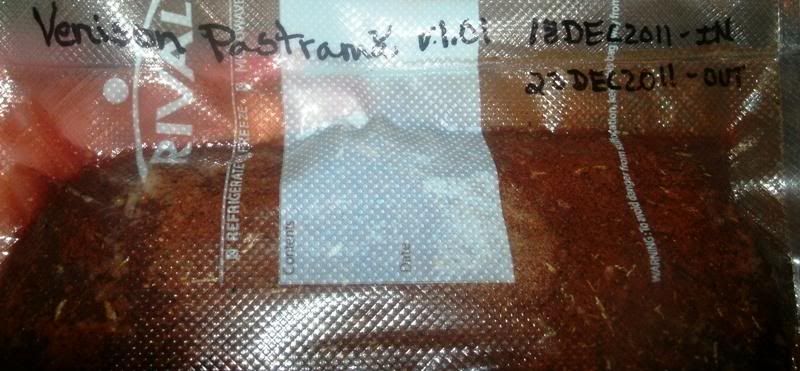 since the meat was between 1 and 2 inches in thickness, i calculated a curing time for 2 inches, consistent with the recommendations found here: http://foodsoftheworld.activeb...rquick_topic935.html adding a little time for safety and - let's face it - to get me to the weekend so that i would actually be able to work on the project. then, i put the roast in the refrigerator in order to let the cure work its magic. i've been turning and massaging the meat once each evening, in order to ensure that the cure is well-distributed. that's it for now - more as it develops..... | ||
|
| Moderator |
The Greeks have this, too; it's called pastourma. We salt-cure and air-dry it for thirty days. George  | |||
|
| one of us |
hi, george - yep, i was doing some research on the internet, and found this: http://foodsoftheworld.activeb...=288&title=pastourma this is a project i am going to try sooner or later ~ the salt-cure" is something i haven't worked up to yet, but would like to. in my reasearch, some forms of pastramă were salt-cured, then air-dried, and i am positive that is the most traditional way of doing it. the research i found on venison pastramă said to cure and season at the same time, so i figured i would try it that way for my first attempt. this would help me "get my feet wet" with the concepts and then i could move it along from there, probably with a greek pastourma project. the finsihed product should be very similar, if not almost identical, except for a few flavourings. if you have any tips or advice, i'd love to hear them! | |||
|
| One of Us |
I have made a couple of Pastramis out of Elk Roasts that have been very successful. A dry rub for 2 weeks a couple of hours in the smoker then boil and slice thin. I'm hungry already gotta get my smoker fixed... Merry Christmas Happy Eating | |||
|
| one of us |
When we last left you, Dear Reader, we had just put the venison roast and cure into a vacuum-seal bag and into the refrigerator to cure for at least 5 days. As it turned out, I didn't get to continue this project until the evening of the 25th of December, so it was a few more days than that, but no worries - a little bit of margin is just fine! Here we are after 7 days of curing, turning, massaging and light pressing: 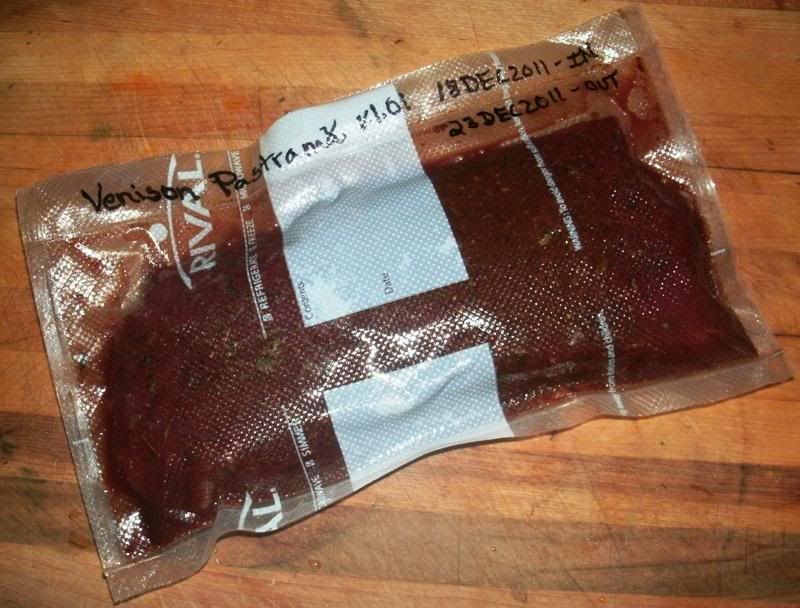 I'm not sure if all of the steps above are necessary, considering the vacuum seal, but as I've said before, it sure didn't hurt. You can see that the curing process brought out quite a bit of moisture, and the venison has taken on a beautiful colour. I soaked the roast in ice-cold water for half an hour, in order to draw out excess saltiness: 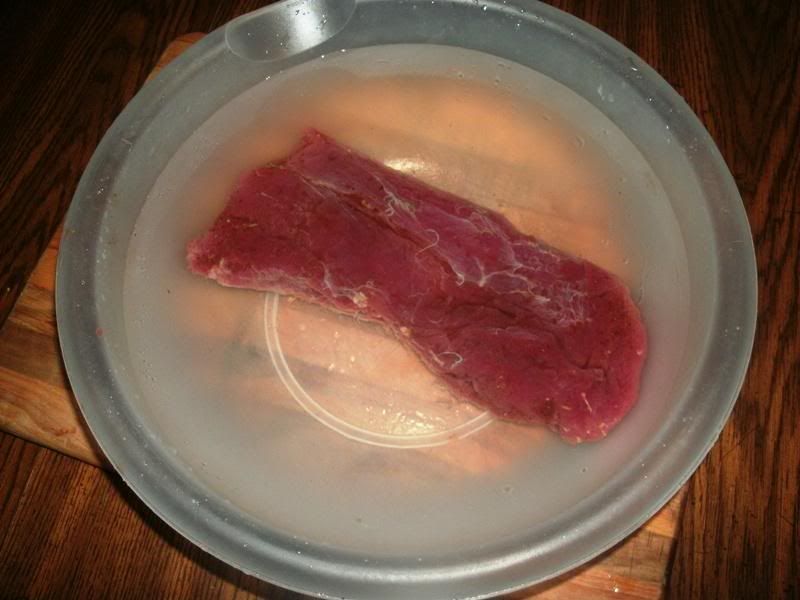 We didn't have any ice, so I kept it in the refrigerator for the allotted time in order to keep the meat as cold as possible. Next, after wiping the roast down with paper towels to dry, I ground some fresh, black pepper over both sides of the cured roast: 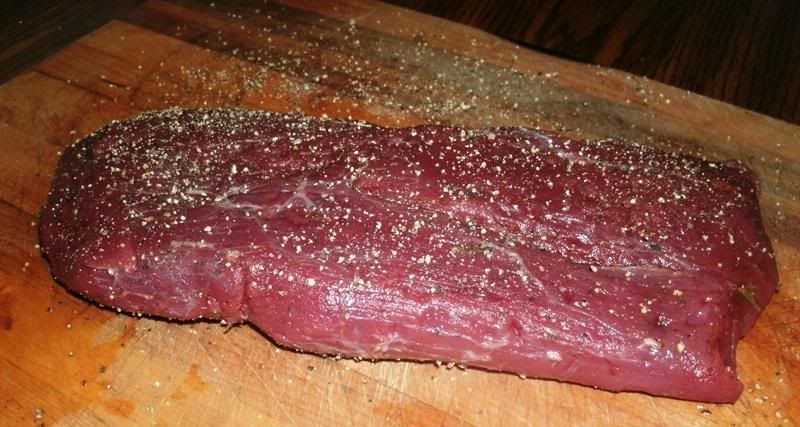 And set it out on one of my smoker racks: 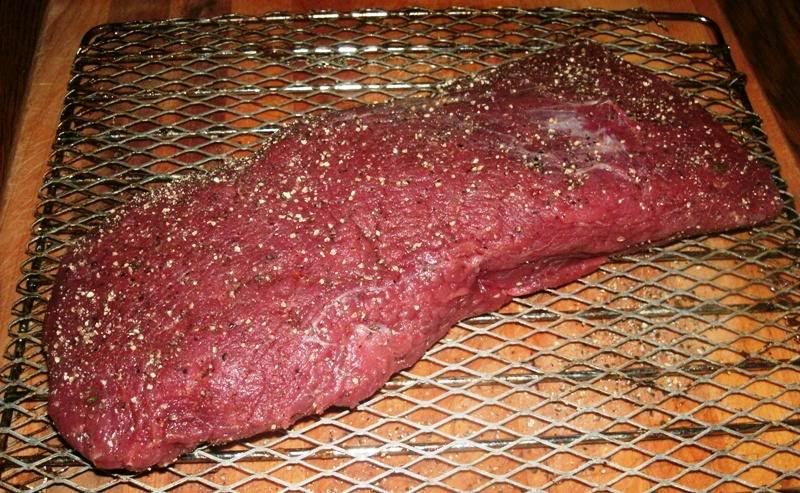 And put it in the refrigerator overnight, uncovered, in order to form a pellicle, which is nothing more than a slightly dry, slightly tacky surface; the pellicle helps with smoke penetration and a better final product. The next day, I set up my Little Chief and began smoking the roast over alder wood chips, which I felt would be a great compliment to the venison. The Little Chief is perfect for projects like this, which call for cooler smoking temperatures rather than "smoke cooking." Smoking is optional, but highly recommended for a wonderful touch. Oak is the traditional smoking wood of choice for pastramă in Romania, but I didn't have any available. I found alder to be perfect for the venison, but that's no reason not to experiment. I imagine cherry, apple or maple would really be something, while hickory, pecan or mesquite would lend wonderful properties of their own. Your imagination is your only boundary. After 8 hours or so of smoking, with some drying, here's what we had: 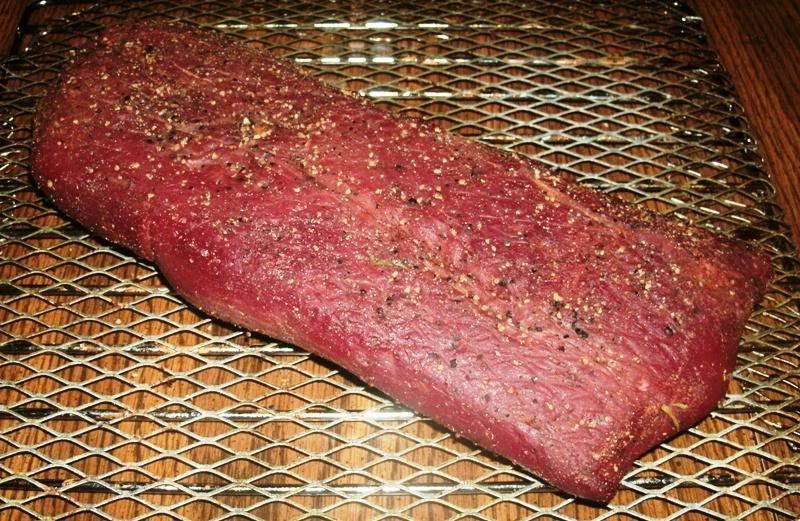 I chose the more "modern" path for the initial cure by using Tenderquick, and will probably try the older, more-traditional salt-curing method next time. However, when it came to the second stage of preparing the pastramă, I went with tradition and, hopefully, flavour. I could probably have finished this in the oven with fine results, bringing it up to "fully cooked and ready to use" temperature as I did with my venison "dried beef" project: http://foodsoftheworld.activeb...t-jerky-from-venison However, being a student of history, I decided to stick with the traditional Romanian method as closely as I could, so I wrapped the pastramă in some netting I had from an onion bag:  And hung it securely out in a location where it would get good air movement. Luckily, our temperatures here have been almost ideal for this the last few days, with lows in the very high 20s and highs in the very low 50s. These extremes are on the fringes of the parameters of my research: http://foodsoftheworld.activeb...astram_topic283.html But not by much, and those extremes have been only during very brief times during a 24-hour period, so I decided to give the traditional method a try. I know from experience that the temperature of hanging meat tends to be pretty stable, especially this time of year, it seems. The slow curing results in a much more savory, tangy aroma and flavour, and I am hoping that comes across in the preparation. I am guessing this method would really have shown benefits earlier in the fall, with the sweet tang of leaves and grasses in the breeze; in fact, the famous Parma hams of Italy are renowned for the essence of the fresh mountain air they are cured in, as they hang in attics of country homes and barns. Unfortunately, it looks like our run of relatively mild temperatures is about to end, so I may end up finishing this in the oven after all - or, I might keep it in a cooler area such as our front porch, which has been blocked off for winter and should fall in the low range of the temperatures found in my research. If you choose, you can take the modern route and put the pastramă in your oven at it's lowest setting for a couple-three hours until the internal temperature is in the 145-degree range, then let it cool down naturally, package it, and keep it in the refrigerator or freezer. Having said that, the traditional, slow, air-cured method is, to me, the best path to the tastiest and most authentic results. The choice, of course is yours. In regards to the air-curing, what I have done so far is based on my research mentioned above, and through my reading of Greek pastourma: http://foodsoftheworld.activeb...=288&title=pastourma However, I am brand-spanking new to curing whole cuts of meat, and air curing, so if anyone has any relevant advice or comments to pass along, I'd be grateful to learn. That's where we are for now - more to come. | |||
|
| one of us |
Alright, this project can officially be called a success, I think! If anyone follows this tutorial as well as the tweaks and suggestions in it, they should be able to have themselves a traditional Romanian specialty of the first order. After my previous post, where I hung (hanged?) the I let the pastramă out in the open air to dry and cure, I left it there from Monday evening to Thursday evening, a total of about 3 days, or 72 hours. The different accounts I read for pastramă said gave different times for this, anywhere from 1 to 5 days; the Greek pastourma instructions advise 2 weeks - but that is in a cellar, rather than the wind, and also has a wet coating applied when it is hung to dry. With all this in mind, I took a middle-of-the road approach and chose 3 days. More on that later. When I brought in the pastramă and cut it from its netting, this is what I found: 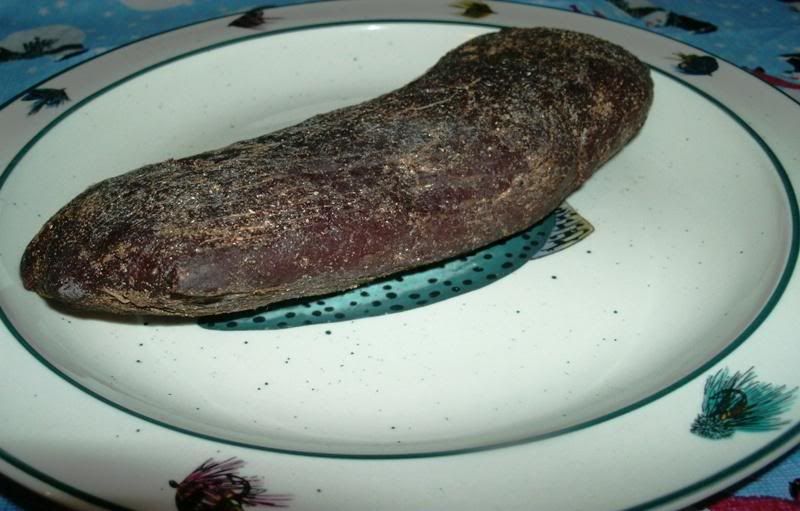 It doesn't look like much, just some dried-up meat, but it did have some interesting properties; chief among them was that it seemed to have "swelled" and had even gotten a little roundish in shape. When I squeezed it, it had some give, but no moisture oozed out, so I figured it was all good. The outside was dry and firm, and smelled like venison, so everything seemed just fine and as it should be. I could have hung it out one more evening, but decided not to. Taking my fillet knife, I carefully carved the pastrama in half. Worried that I hadn't done this right, I kept expecting juice (or something) to squirt out into my eye, but nothing of the sort happened. It slices beautifully to reveal this: 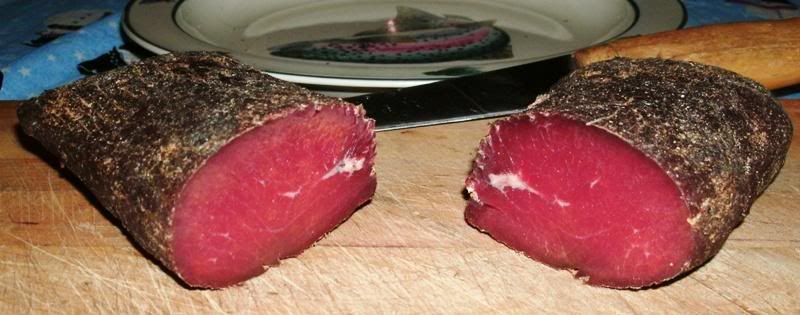 Just like the pictures I had seen ~ actually, this picture is a little lighter than it actually was - in truth it was rather dark in colour, with the thin thread of fat lending a milky contrast. I was still pretty amazed at the lack of visible moisture. The meat itself inside the dried, natural "case" was very soft and not dry at all: 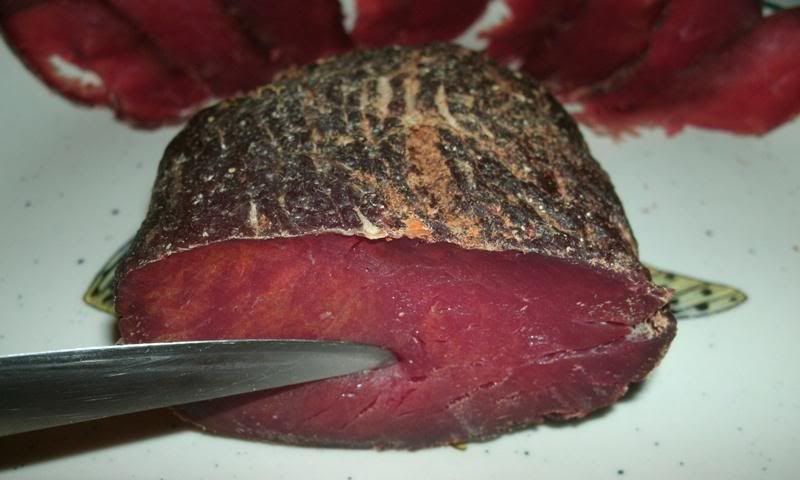 But even when squeezed and pressed with the tip of the knife, there was no oozing, so I put that worry aside and set up my slicer. The pastramă was fairly-well-chilled, but slicing was a bit of a challenge due to the soft texture of the meat: 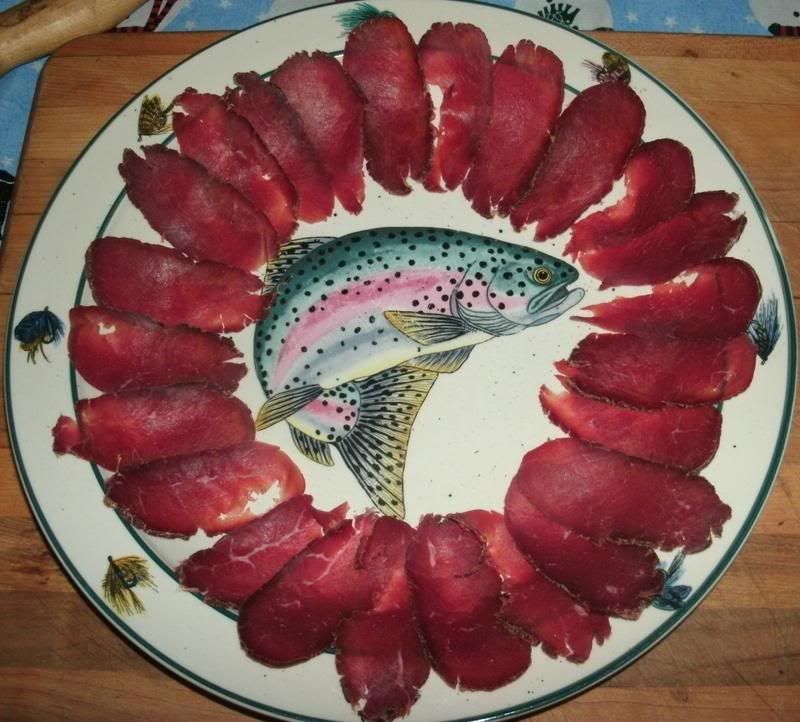 So I put the other half in the freezer to firm up while I sliced the first half. As with any similar product, the thinner you can slice it, the better, for optimum texture and flavour. The thinnest slices, nearly transparent, are best: 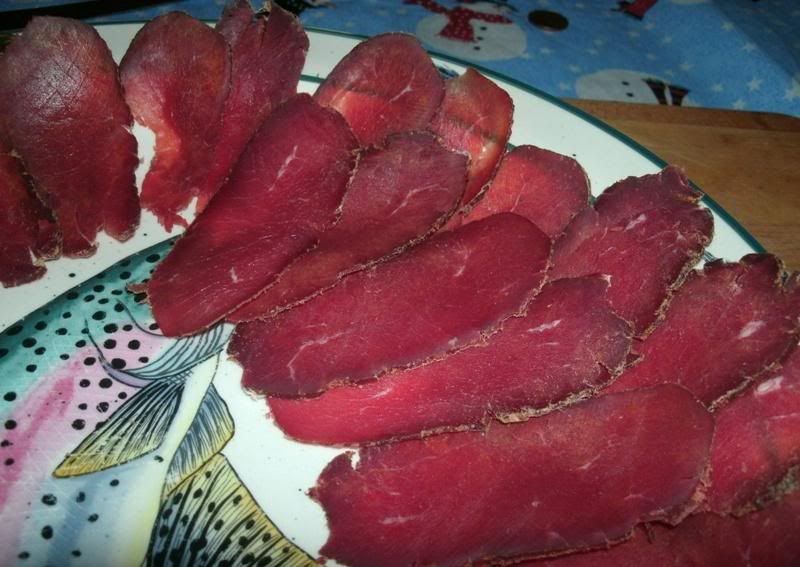 I was able to get most of them very thin, but I am still learning with this slicer. One thing's for sure, the closer to frozen (without actually being frozen), the easier it is. Here's the first half, minus a few samples and scraps, sliced and ready to be packaged: 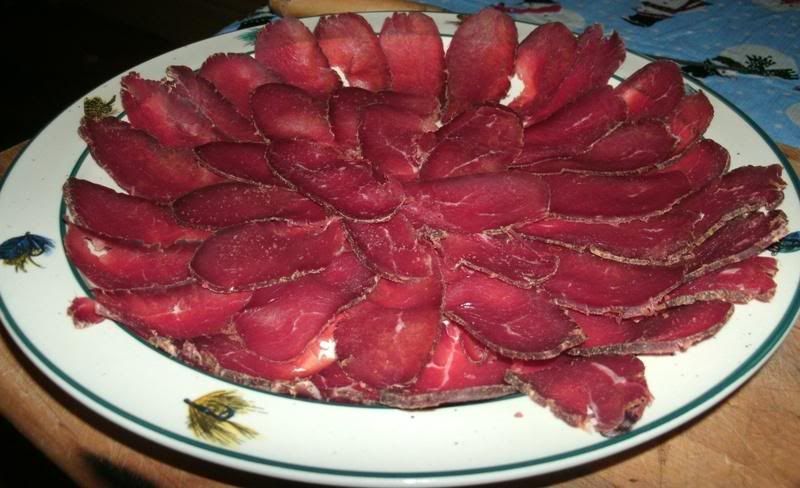 When I brought the second half out of the freezer, it was much firmer to the touch, but still pliable: 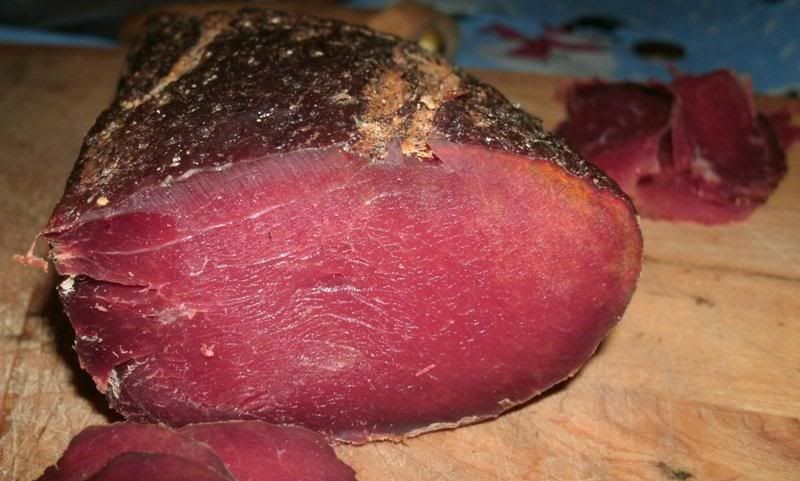 I began slicing, and had a much easier time of it. With both halves, the blade kept catching on something toward the end of the slice, and would tear at the slice a little. I assumed this had something to do with the firmer outer layer, as well as the delicate softness of the interior, so while it was easier with the second half, it was still a fine line to walk when trying to get them just right: 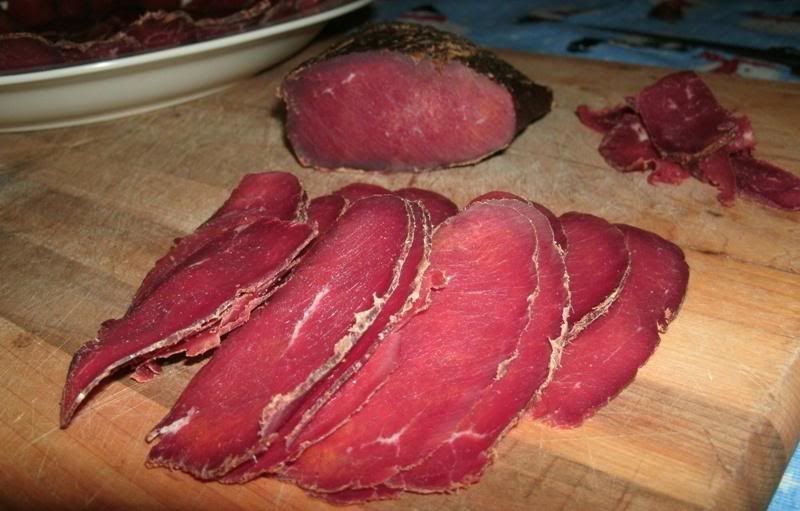 Here's the second half, ready to go: 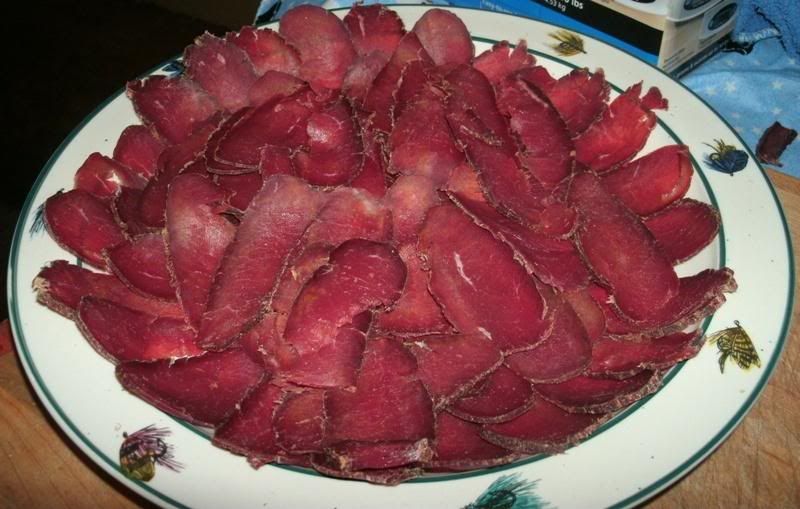 Looking awfully nice, if you ask me! I did sample some, as I mentioned above, and passed a few around to the family, as well. The beautiful Mrs. Tas didn't like it, which was expected; the pastramă is made from deer, and it is smoked - that's two strikes against it, as far as she was concerned. The kids seemed to all like it, and were hanging around hoping for more samples, but I had plans for the rest. As for myself, I really liked it. From what I have read, pastramă is either eaten two ways: 1) As-is, cut straight off the roast, like a cold-cut, I guess, or 2) It is also "grilled," which in a lot of foreign countries means "pan-fried," sort of like bacon or ham - but can also mean grilled over a fire. The "cold-cut" was really interesting. As far as taste, many of the flavours came through - the venison itself, the pepper, the garlic and of course the tangy alder smoke. But there was also a rustic quality to it, an extra layer or two of depth brought on by the other spices, as well as the curing. Where texture was concerned, if you've ever had gravlax or prosciutto-type hams, it reminded me of those. It’s definitely different, but very good. An interesting, historic account on this can be found in the 10 May 1921 publication of the Wisconsin Rapids Daily Tribune:
That pretty much describes it right there, especially with the thicker pieces. The thinnest ones were different, practically melted on the tongue as they released their flavour explosion really bringing out the savory goodness that must be experienced to be appreciated. My only real complaint is that the herbs and spices (cinnamon, coriander, savory, paprika and allspice) didn't really come through as much as I wanted. By adding them with the cure, I don't think they came through as well as they could have, except the garlic, which comes through really nicely and worked very well with the cure, the pepper and the smoke. Perhaps next time, I will double the amount of these other flavours and/or make a paste with them and slather them on the pastramă while air-curing. Speaking of the air-curing - as mentioned above, I hung it out in mild temperatures (no higher than about 54, no lower than 27) with plenty of good air-movement (well, to be truthful, it was downright windy for most of the time) for 3 nights and 2 days. It was perfectly fine this way - there was no "drippy" moisture at all inside, so it was all good, but I think it could have benefitted from a couple more days, just to develop its flavours and textures a little more. This is a hypothesis only, to be tested sometime in the future. Having procured batteries for my digital scale, I put a plate on the tray and turned the scale on, which zeros it out at the same time. Then I put all of my pastramă slices on it and discovered I had 10 ounces of finished, usable product: 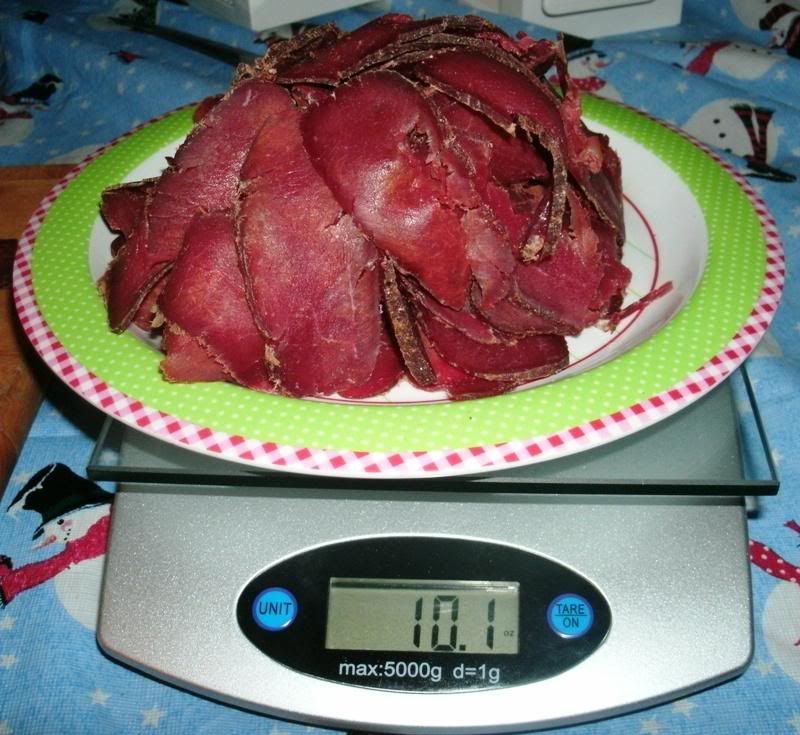 So I divided the pile into two smaller piles of 5 ounces each: 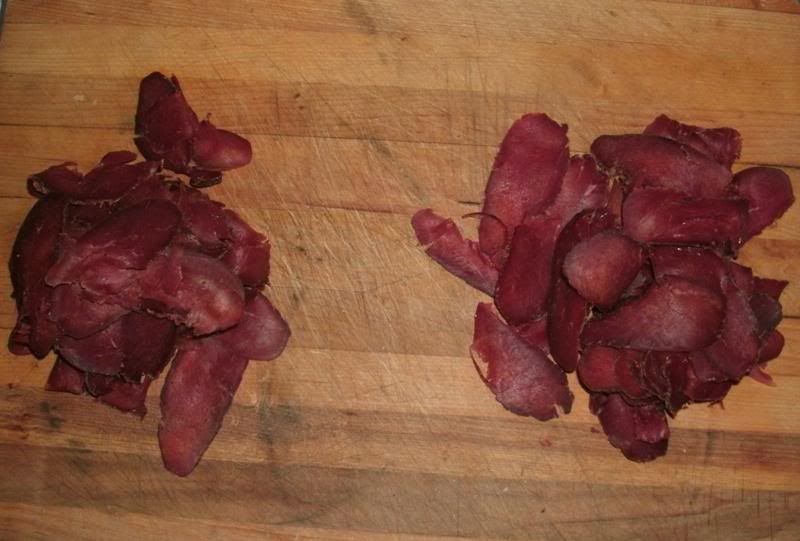 And then arranged each pile into four stacks. The stacks averaged 12 slices tall, and I ended up with 2 "portions" - of 49 slices - for each 5-ounce pile. I then vacuum-sealed each portion: 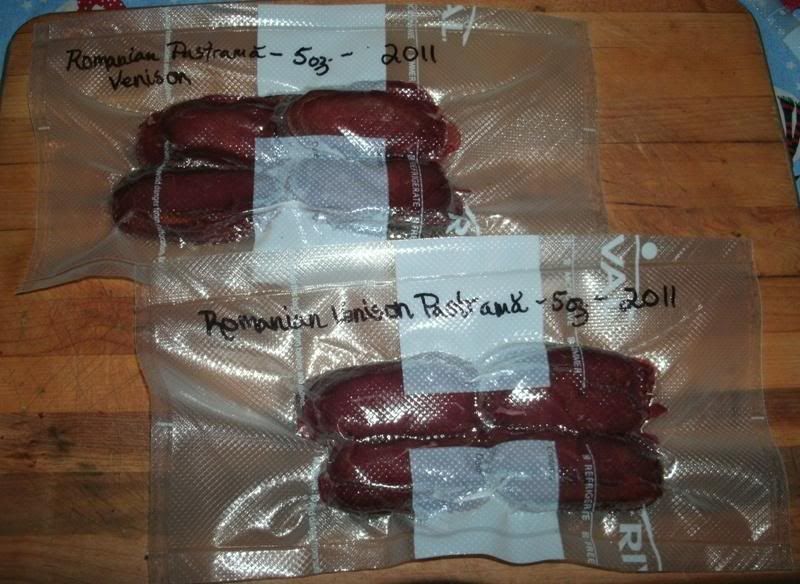 And put them in the freezer. Meanwhile, I had this small portion of scraps - some too thick, some torn up etc. - that was about 3 ounces: 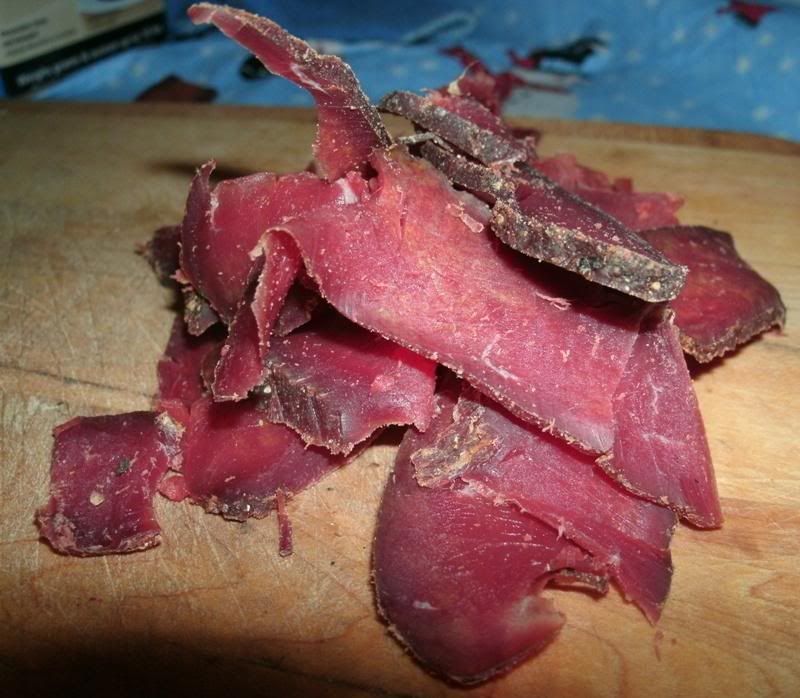 What to do? Well, as I said above, another preparation technique for pastramă is to grill it, so I sprayed a little olive oil in a small frying pan and did just that: 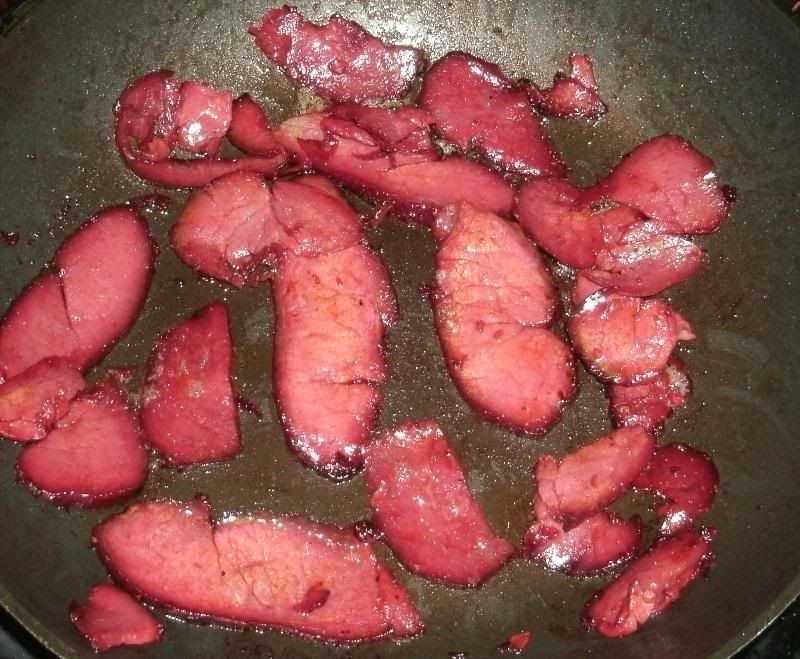 As the kitchen filled with a wonderful tangy-smoky aroma, somewhere between bacon and ham, I stirred the pastramă around in the pan until it seemed done, then set the pieces on a paper towel for a moment before trying them: 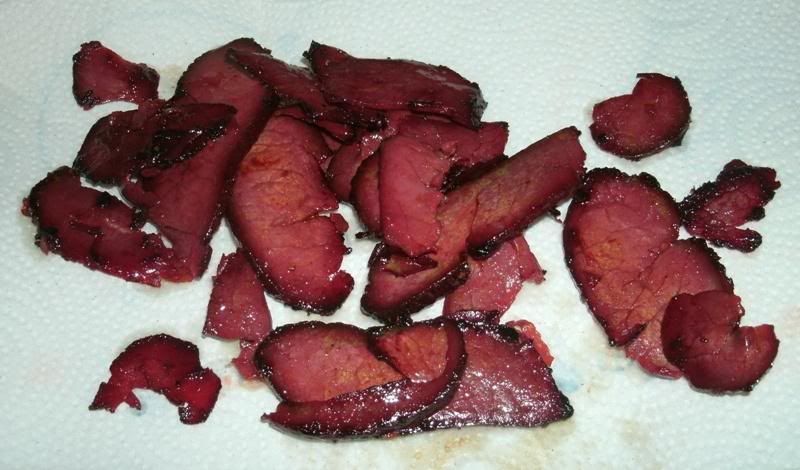 I looked around fro some bread, dinner rolls, or even some crackers to try it with, but couldn't find any (it's the end of the pay period and there's nothing in the house - yay!), so I sampled the pastramă by itself and shared it with the boys. Conclusions were unanimous all-around - it was very good! As I alluded above, it tasted like kind of a spicy cross between bacon and ham. I could easily see this as a great sandwich meat (when sliced thinly), or chopped fine and mixed with some vegetables as a side item, or sitting on top of a salad - or even on its own next to a side dish such as mashed potatoes or traditional Romanian mămăligă, which is basically the same thing as polenta. Heck, if a person wanted to dice or mince it and put it on vanilla ice cream I think it might even be good - they do it with bacon nowadays, so why not? That's about all I have - and I am definitely calling this project a success. From what I can tell, it is textbook, traditional pastramă, but I've got a couple of ideas that might make it even better next time: 1) For the first stage, I'll try curing it in natural salt, as described in much of my research. I'll read more on this in order to do it right, but it seems that this time-honoured method should be relatively free of complications. 2) For the air-curing stage, I’ll coat it with a paste made from the "other seasonings" (described in the opening post) ground and mashed with the garlic, adding a little water if necessary. The basic idea behind this is mentioned in most of my pastramă research, and there is a good visual example in the post on Greek pastourma: http://foodsoftheworld.activeb...=288&title=pastourma Hopefully this method will allow me (or YOU, if you try it!) to get more of the awesome, exotic flavours through for an improvement - but even when made exactly as I did, pastramă is a very enjoyable, wonderful thing. If anyone wants to give this a shot, all the information should be here for you, but if you have questions, just ask! As with many of these specialties, it works with pretty much any meat: deer, beef, mutton - even goose, turkey or pork, so no matter what you like, you can make it even better by making pastramă out of it ~ Thanks for taking a look at this, and I look forward to comments, questions or replies - Ron | |||
|
| one of us |
| |||
|
| Powered by Social Strata |
| Please Wait. Your request is being processed... |
|

Visit our on-line store for AR Memorabilia

